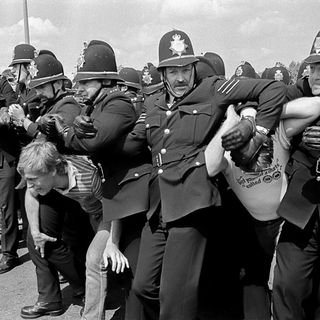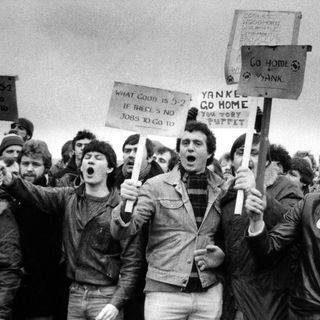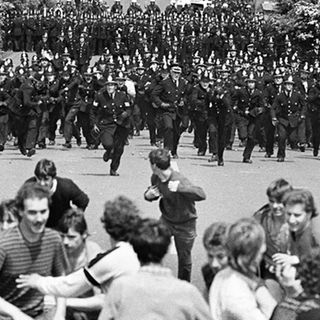The Miners' Strike of 1984-1985
Notes & Videos
While the information on this page does cover the major points of The Miners’ Strike of 1984-1985, that’s a lot to read through and digest.
If you’d like to start with some videos overviewing the Miners’ Strike, I’d recommend the ones below. Please note – there are clips of police violence from the strike in a few of them. The last two videos are from a much more recent colliery closure, but they do a great job of centering just how much these mines mean to these workers.
Coal Mining & The Strike of 1972
At the start of the 20th century, there were more than 1,000 collieries (coal mines) in operation across the UK. Coal mining was nationalized by the government in 1947, and most collieries were run by the National Coal Board (NCB) from that year on.
Pit communities formed near these collieries – entire villages were built by colliery owners to house their workers. These villages were dedicated to the occupation, their economies entirely dependent upon how well the collieries were doing that year. These communities were often tight-knit, and generations upon generations of miners worked in the same pit.
The importance of the collieries to these communities, to these families, to these generations of miners is key.
The collieries were all these communities had.
The number of collieries in the UK dwindled down from over 1,000 in the early 20th century to a mere 173 by 1984. Employment dropped from 1 million to just above a quarter of that number. Coal mining is a resource-based industry – there was a decline across the world in the mid-to-late 20th century, as coal began to be replaced by oil, natural gas, and electricity. Although this decline was worrisome to the miners and their communities, it was a decline that was happening across the globe.
In January of 1972, the National Union of Mineworkers (NUM) went on strike against the NCB over unjust pay – miners’ wages had not kept pace with those of other industrial workers since 1960. This strike was successful – miners gained the support of railway, power station, dock, and fuel storage depot workers, who went on strike in solidarity, causing power shortages across the UK. Exceptions were made – the miners and these workers ensured that hospitals, nursing homes, orphanages, and schools still had a decent supply, while holding other stockpiles of coal hostage for leverage against the NCB.
By early February, a state of emergency was declared due to unexpectedly cold weather and a lack of power across the entire national grid.
Although most of the picketing was fairly peaceful in this strike, the death of miner Fred Matthews by a scab lorry driver gained the attention of members of Parliament, as his death could easily amp up the strike to a more violent level.
Thankfully, the strike of 1972 came to an end when over 2,000 NUM members arrived in Birmingham to picket an operating coke plant with a stockpile of coal, and were joined by over ten thousand workers from other industries. A deal for fair pay was made, thanks to the collaboration and solidarity of workers across the UK.

The Three-Day Week
In the 1970s, most the of the UK’s electricity was produced by coal-burning power stations. In order to reduce electricity consumption and conserve coal stocks, the Prime Minister at the time, Edward Heath, announced the Three-Day Work Order, also known as the Three-Day Week. This work order would limit commercial consumption of electricity to three consecutive days each week. Essentially, electricity was being rationed across the nation in order to avoid the overconsumption of coal.
But Devon, you ask, why would they want to consume less coal? We’re rooting for these miners – don’t they want the work?
They did want the work. The trouble was that at many collieries in the nation, the coal worth mining for was getting more and more expensive to access. Coal is not a replenishable resource – once it’s mined, it’s mined. Thus, miners had to access more dangerous locations, and often needed different tools, or more expensive machinery in order to mine the coal. The National Coal Board determined that paying this amount of money was not worthwhile, especially with different resources on the horizon.
The Three-Day Week did not last very long, thanks to unsustainable nature of the rationing, as well as the NUM going on strike again in 1974 against a miniscule pay increase. Their demands were met, and the Three-Day Week phased out as the coal supply increased once more.

Margaret Thatcher
Margaret Thatcher (also known as Maggie Thatcher), was the Prime Minister of the United Kingdom from 1979 to 1990, and the Leader of the Conservative Party during the same era. Her uncompromising politics and unwavering leadership style earned her the nickname “The Iron Lady,” and she is still referred to as such today.
Although there is a lot to learn about Maggie Thatcher, this segment will focus mainly on her ties to The Strike of 1984-1985.
Thatcher believed that trade unions (or labor unions) as a whole were harmful, especially to the economy. She spent her time in office committed to reducing the power of the unions, whose leadership she accused of undermining parliamentary democracy, and also of affecting economic performance through strike action (see the previous sections on the Strike of 1972 & The Three-Day Week).
In order to reduce the power of these unions, Thatcher focused on privatizing state-owned industries, including both steel and coal. These industries both relied heavily on government subsidies, and by privatizing them, the nation would see economic growth. She could see just how much power these unions had, especially in the downfall of previous Prime Minister, Edward Heath, and determined that reducing their power would lead to a better Britain, and a large success in her own career.

The Strike of 1984-1985
The Miners’ Strike of 1984-1985 has gone down in history as one of the most grueling and violent industrial disputes Britain has ever seen. Miners and pit communities from South Wales to Scotland fought to retain their local collieries after Ian MacGregor of The National Coal Board announced in March of 1984 that they intended to close 20 pits across the nation. This made all that the miners had fought for in the 1974 strike obsolete – it would cause the loss over 20,000 jobs, and would bring the economic life of pit communities to a full halt.
“Don’t let MacGregor rape and pillage – if they close a pit they kill a village.”
– Common Picket Sign from the 1980s.
Less than a week after the NCB made this announcement, Arthur Scargill, president of the National Union of Mineworkers, called for a national strike against these pit closures. Controversially, Scargill never held a national vote within the NUM, and not all miners were on board with this walkout. This caused their mission to become muddled in many ways – in some parts of the country, miners kept working, causing tensions with picketing workers who branded them as scabs.
The miners who did choose to strike used aggressive picketing tactics, led by Scargill, and managed to shut down many pits across the UK. However, Margaret Thatcher had learned from the previous strikes, and from the former Prime Minister’s mistakes. She had taken the steps to stockpile enough coal to keep the country supplied for at least six months in case of a strike. She had also made secret deals with non-unionized drivers to transport the coal, ensuring that power outages would not bring the UK to a standstill like they had in previous strikes. NUM president Arthur Scargill unfortunately played right into her hands by ignoring Thatcher’s growing coal stockpiles, and by calling the strike at the end of winter when the demand for coal was declining.
“I am not prepared quietly to accept the destruction of the coal industry, nor am I willing to see our social services decimated.” – Arthur Scargill.
The strike was universally observed in South Wales, Yorkshire, Scotland, North East England, and Kent, but due to the lack of a national ballot, there was less support across the Midlands and in North Wales. The miners on strike faced off against Thatcher’s police forces, resulting in many clashes that often turned violent.
On June 18th, 1984, the Battle of Orgreave took place. Striking miners attempted to blockade the Orgreave Coking Plant. This is the footage in most of the above videos – about 5,000 miners and 5,000 police broke into violence after the police charged on horseback with clubs drawn. It became clear that Margaret Thatcher was not pulling her punches in the amount of police she sent to each strike location, and that many of these miners did not stand a chance against the police force, their horses, or their weapons. In fact, most of the police officers stationed at picketing locations across the nation were making overtime pay.
“Keep it up ‘til Christmas, lads, it means a lot to us. We send our kids to private school on a private bus. We’ve got a lot to thank you for, Geordie, you’re a corker. A nice extension on the house and a fortnight in Majorca.”
The strike began to lose steam because of the lack of a national ballot from the NUM. The Nottinghamshire NUM broke off into a separate union called the Union of Democratic Mineworkers, collecting members from more isolated pit communities, many of whom still needed the work. When MacGregor of the National Coal Board included this new union in wage negotiations, the strike weakened even more.
Many miners chose to cross the picket lines throughout the strike, causing anger, violence amongst miners, and a general loss of morale. The amount of scabs increased in January of 1985, when strikers struggled to pay for food as the union pay ran out.
“What’s left here, eh? We’re screwed; they’ve already started going back. What’s the point? What’s the point in trying to keep your pit open? What’s the point in trying to keep your community together? What’s the point in trying to keep your family together anyway?”
The strike came to an official end on March 3rd, 1985. The National Coal Board decided to postpone the closure of five pits, but otherwise did not budge on their decisions. Many miners went back to work, the strike lost. Miners’ wives organized the distribution of carnations, the flower symbolizing the hero, at the pit gates the day the miners returned to work.
Strike Context
Here’s another way we can look at this strike, and see what worked and what didn’t work: within the past year, both the WGA and SAG-AFTRA went on strike because their needs were not met during contract negotiations. These unions both succeeded in the overall strikes because there was solidarity across the board – writers stood with actors, actors stood with writers, and even IATSE members who were not technically on strike respected picket lines for the most part.
The people were unified, and thus, eventually deals were made.
“Solidarity, solidarity, solidarity forever. All for one and one for all, solidarity forever.”
In the Strike of 1984-1985, the miners were not unified. This is largely due to the fact that Arthur Scargill of the NUM did not hold a national ballot, and therefore didn’t get the “green light” from the various NUM branches across the UK before deciding to proceed with the strike. Each individual branch took votes, leading to some branches continuing to work, and others striking – which eventually led to a lot of in-fighting amongst the mining community.
It also did not help that Prime Minister Margaret Thatcher stockpiled coal in anticipation of a strike, allowing the government to continue operating as usual without any supply chain issues.
History, Legacy, & Honor
As mentioned before, these pit communities were deeply tied to the mining profession. More often than not, these families had been here since the pit opened – your father, grandfather, and great-grandfather were likely all miners, and if you were male, you likely would be too. There was great honor in being a coal miner, and there was an expectation that this was what life was.
“This isn’t about us, Dad. It’s not about the kid. It’s all of us, this is everybody’s chance. It’s everybody’s future. It’s everybody’s past. It’s not about a bairn who wants to dance. It’s about our history. It’s about our rights. Think about the sacrifice we’ve made. It’s what you always taught us since I was a lad.”
It was rare, at the time, for children in mining families to “get out.” Most mining daughters eventually became mining wives. Most sons became miners. This is part of the reason for Billy’s reaction at the Royal Ballet School audition – he chooses violence because the men in his community are familiar with that language. This is also why Billy’s journey frustrates Tony, but at the same time, inspires many within their community.
Billy represents the chance to be something more.
Billy represents a flicker of hope within the community.





